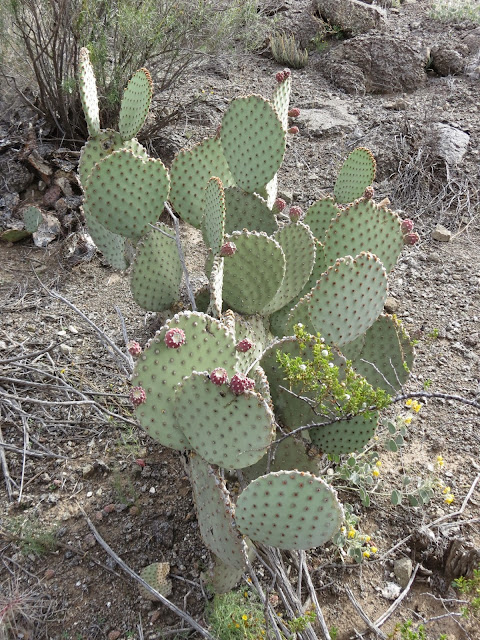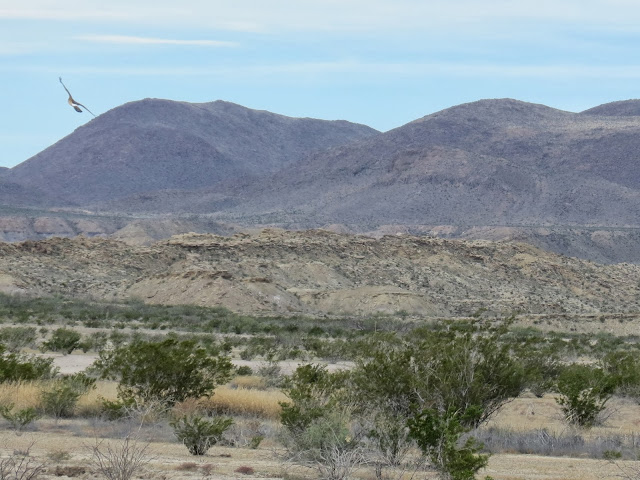The night sky at Big Bend is something to behold revealing more stars than you imagined existed.
And sunrises are as beautiful as sunsets. We've seen the river, so today we're going to explore Big Bend's two other ecozones, the mountains and the desert.
As we started out on our third and final day here, bicycles weren't the only thing to watch for on the roadways.The Roadrunners were out hunting for lizards. Did you know they can run up to 20 mph?
As we approach the Chisos Mountains, we spotted another Roadrunner perched in a tree.
The mountains are the realm of lions and bears, oh my!
And unlike the desert below, the mountains get enough rainfall to sustain large trees.
The Chisos Mountains.
The road is steep and curvy in places, not recommended for RVs or trailers over 24 feet.
The road ends in a basin surrounded by the mountains. You can see the campground down there. We traveled by car.
In the Visitor's Center there's a replica and information about the mountain lion, as well as dates and places of recent sightings. One was seen in the campground just a few days ago.
What to do if you see one. It doesn't mention taking a picture...
Here's what he might look like out on a trail.
There are many trails here into the mountains. We just took the short paved one to the viewpoint. We had a lot of territory to cover today.
Birdie looking at the "Window"Close up of the Window between the mountains.
I thought this was interesting about the aspens.
Can you see the aspens?
We left the mountains to spend some time exploring the Chihuahuan Desert. There is a gravel road called "Dagger Flat Auto Trail" that we plan to drive. On the way we stopped to see a couple of points of interest.
The spring and cottonwoods are no longer here.
This area of the desert was once an ancient seabed, and then a swampland supporting prehistoric animals whose fossils have been found here.
We stopped at a picnic area that had a fossil bone exhibit.
The fossils on display are really replicas of ones found, and secured behind glass.
Ancient rock layers.
What the terrain looks like.
Some fossils were found way out there. A new trail is being planned to take you there.
It was Birdie's turn to drive today into the wilderness, but my car is the one that got a thorn in its tire....go figure.
The guide book says that the Chihuahuan Desert is the second largest in North America.
The Dagger Flat Auto Trail is all about learning the desert plants that grow here. If you already know about desert plants, you might want to skip this part. It was mostly all new to me though.
This is a Lechuguilla, meaning "little lettuce" in Spanish. Hikers call it a "shin dagger" because the stout leaves can puncture your skin....or even a tire!
The Creosote Bush is one of the most successful of desert plants. Tiny leaves covered by a protective varnish help it to conserve water.Ocotillo will produce tiny leaves after a rain, that drop off to conserve moisture when it doesn't rain. It can still photosynthesize through green stripes on its bark.
Strawberry Pitaya, a cactus that produces brilliant magenta flowers that attract insects that help in pollination. Its spines protect it from other creatures. Too bad it's the wrong time of year to see those blooms.
The Texas Persimmon grows in a "wash," where water flows after a rain. It provides sweet fruit for the wildlife that use the wash for a trail.
Persimmon
The Torrey Yucca is the most common yucca in Big Bend. (Says I who never knew there was more than one kind of yucca, lol.)
Igneous Hills: These hills are the eroded remains of volcanic sill, dark volcanic rock that was shot up from a plume of magma deep in the earth. It did not erupt. A rock layer above the magma prevented it from reaching the surface.
The magma, under incredible pressure injected itself between two layers of light-colored limestone.
Soaptree Yucca is the tallest yucca in Big Bend, some over 30 feet. They grow very slowly, so large ones may be 250 to 300 years old.
Prickly Pear Cactus. Big Bend is home to 9 different species and 13 varieties. They also hybridize making identification difficult.
The Deadhorse Mountains...remote and largely unexplored. The Rio Grande has carved Boquillas Canyon through the southern end.
The Littleleaf Leadtree produces yellow flower balls after a good rain.
Candelilla looks like a clump of slender, spineless cacti, but are actually related to the poinsettia and castor-bean. It stores water in its stems and are covered with a protective, waxy coating that conserves water.
Very old rocks: The hard Buda Limestone forms the top of the cliff and rests on top of softer layers of Del Rio Clay. These rock layers were laid down on the floor of an ancient sea during the Cretaceous Period about 95 million years ago.
We are now entering a forest of Giant Dagger Yuccas, abundant here, but rare in other areas of the park. They can reach 30 feet in height and 2 feet in diameter. In late spring they burst into bloom with hundreds of creamy white flowers. (Note to self...come back in the spring next time)
Giant Dagger Yucca forest.
Thompson Yucca has narrow leaves. It is popular for landscaping.Honey Mesquite: the hard seeds pass through the digestive tract of cattle which transport it some distance, increasing the spread of mesquite. They have needle-like thorns, and may be the culprit that got my tire, as one was growing in my campsite where I parked it.
This Northern Harrier (on the left) was hunting over the desert.
There were many other side roads we didn't have time to explore, some requiring 4-wheel drive.
But we got a good sampling of the park and plenty of reasons to come back again. Hope you enjoyed the tour.



















































Nice tour. Looks like Big Bend has everything. You sure packed in a lot of info.
ReplyDeleteLove that shot of Birdie at the interpretive sign on the overlook. Who could resist exploring those mountains!?!
ReplyDelete